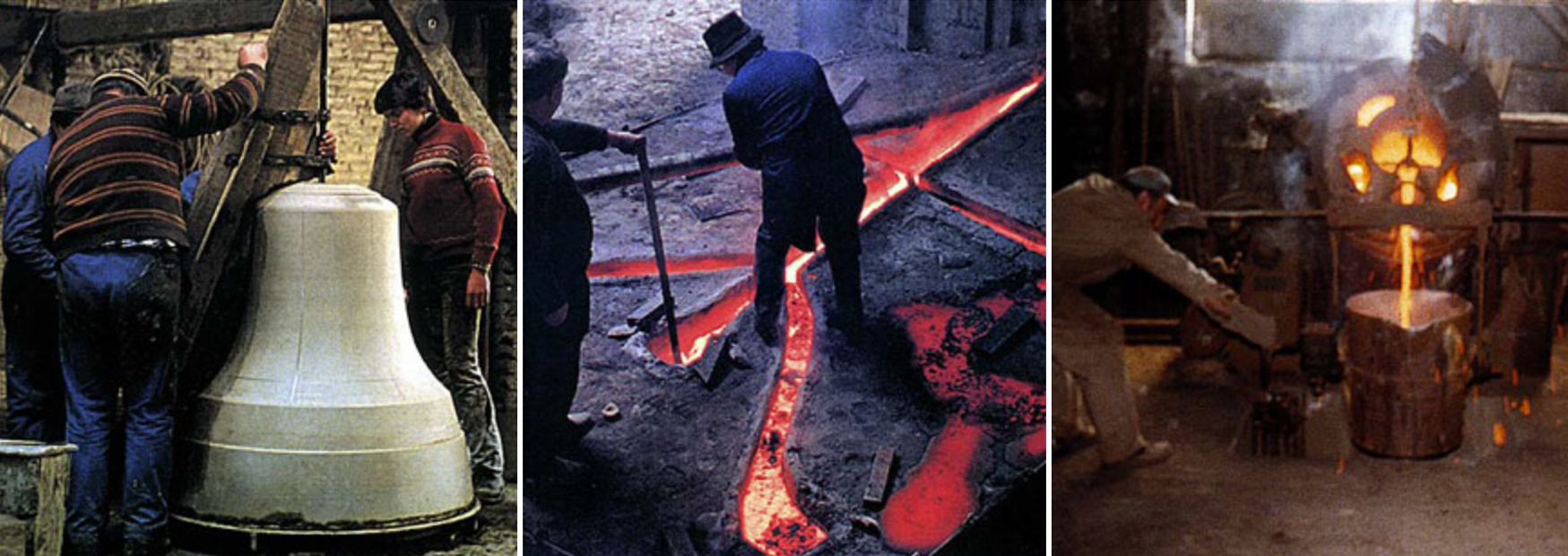Casting and Founders
What material is the bell made of?
The bronze alloy used to make bells general consists of four parts copper and one part tin.
The Materials
The tin has the characteristic of sweetening the sound, even if it makes the alloy softer and, therefore, more “vulnerable” to the blows of the striker, which is made of soft iron.
The tin could also be replaced with silver, which would certainly confer great sound quality to the bell, but an alloy containing about 20% silver would be exorbitantly expensive. Nevertheless, silver is present, in minimal percentages, in the alloys of ancient bells, due to the custom, linked to popular devotion, of tossing silver, and sometimes even gold, coins into the crucible for pouring the “sacred bronzes”; obviously, such minimum quantities would absolutely not produce any significant variation in the sound quality of the bells.
The league of bells
Normally, an alloy consisting of 22% tin and 78% bronze is used.
%
TIN
%
BRONZE

Come avviene la fusione
During the casting process, a very hard, compact form made of bricks and clay, called “the male” is used to reproduce the shape of the interior of the bell and a layer of clay mixed with natural fibers, that is more easily removed, is applied to the outside to reproduce the future exterior shape of the bell. On this shape, called the “false bell”, which constitutes the total definitive shape of the emerging bell, models of the decorations and inscriptions are applied used a thin layer of wax. Everything is enclosed in another clay form, “the shirt”, whose walls will be determined by the false bell completed by the inscriptions and decorations applied in wax that the false bell must adhere to perfectly.
The two superimposed clay forms are then fired; this firing causes the immediate melting of the think layer of wax used for the decorations, but whose imprint remains perfectly impressed in the inside wall of the shirt, in such a way that it comprises the exact outer shape (in negative) of the emerging bell. After the firing is completed, the shirt is removed to allow cleaning the male through the removal of the soft layer that was applied, thus creating the volume and shape that will be occupied by the poured bronze.
After this delicate operation, the shirt is once again perfectly reconnected with the male and arranged in the casting hole and the melted metal (casting temperature of 1100° C) is finally poured between the two forms. After cooling, which can last for quite a few days, the form is opened and the bell, cleaned and polished, appears complete and ready to be admired.
Casting bells is a difficult and very delicate art and is based, first of all, on a precise design, represented in extremely summarized form by the profile of the bell, on which its size, musical note, tone and pleasantness of the sound depend.
Request information
Do you need to realize a new bell?
The melting of the bells in history
Bells were initially cast in monasteries, but around the 11th century, itinerant founders began to appear, often legendary figures, prepared to throw themselves into the crucible if the casting was not perfect. The greatest casters in the world were the Belgians and Dutch: the two greatest representatives of this category were François and Pierre Hémony, two Belgian founders from the 17th century.
In Italy, the most celebrated founders were the masters from Lucca, Pisa and Florence: Vennes, Pisanus, Dainensis and Aretinus, to cite the most famous names of the 14th century.
There are families that handed down this art from father to son for centuries (the Campanato family of Venice cast bells for three centuries) and that still continue to this day. In the long succession from father to son, it can naturally happen that the son is a daughter. There were many women who established themselves in this craft. We mention Camilla, Pantasilea and Barbara, a dynasty of foundry women from Sant’Angelo in Vado in the Marches.
